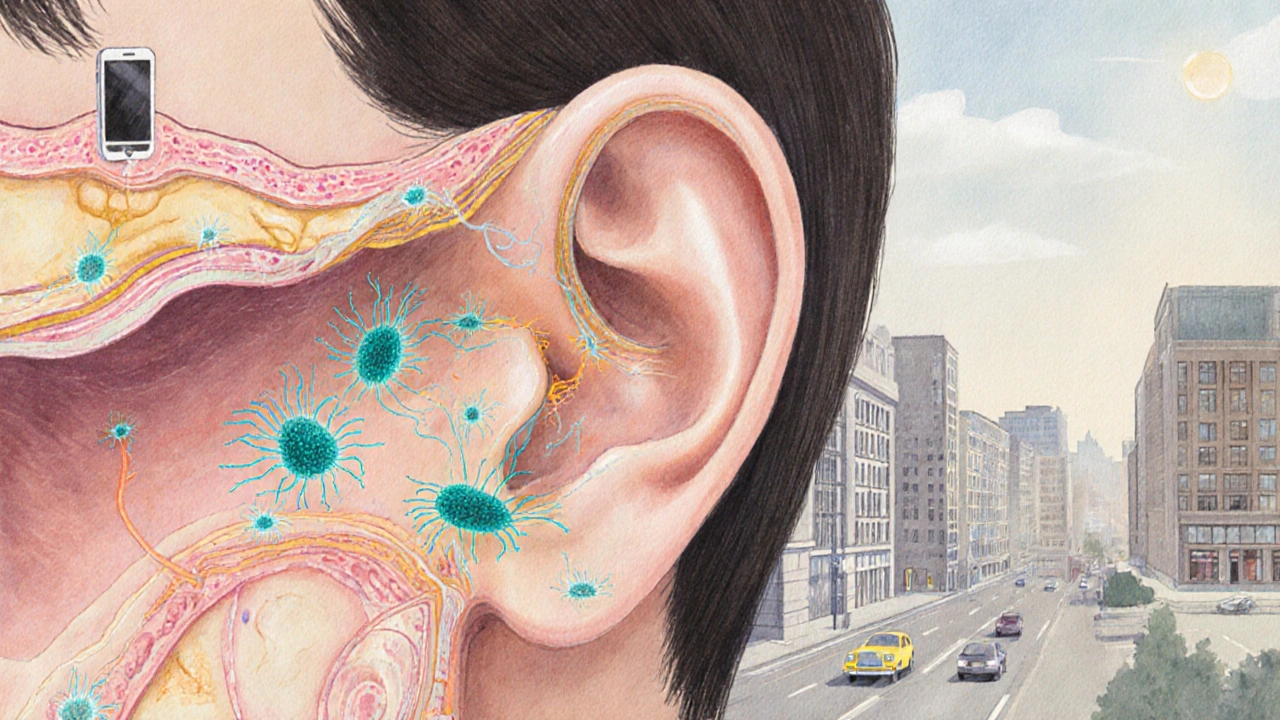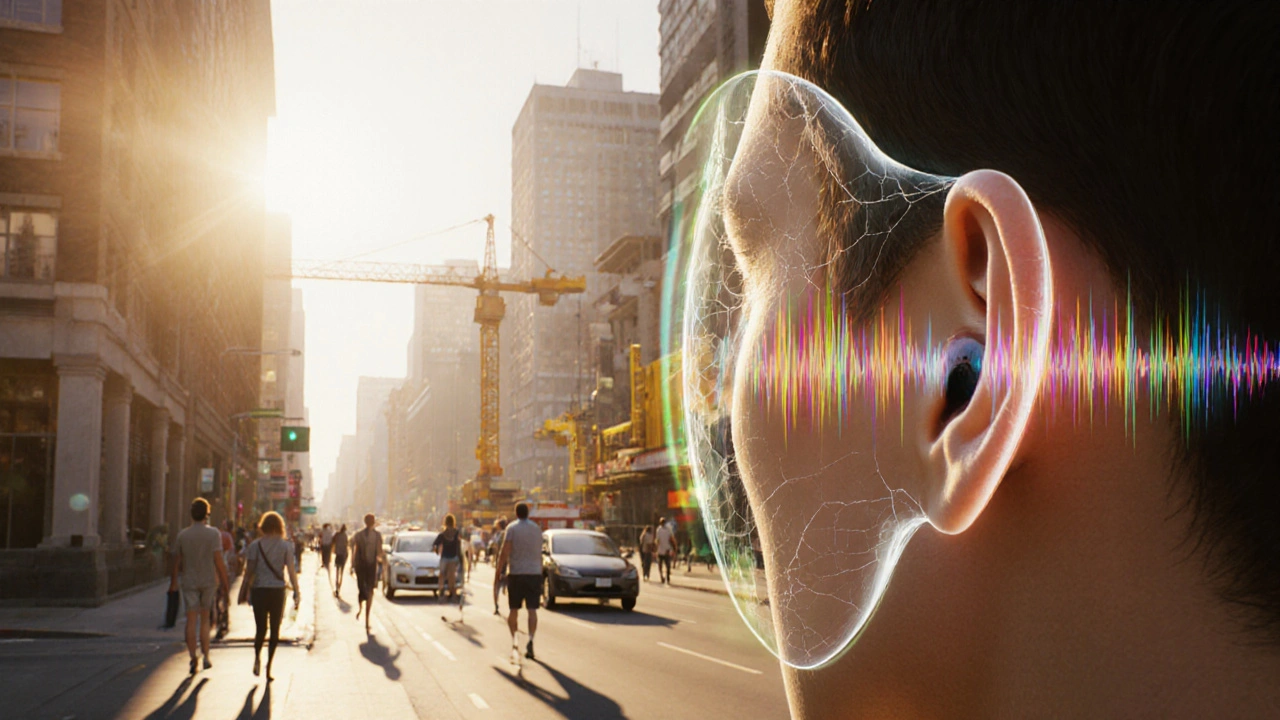Safe Listening Time Calculator
Adjust the volume level to see how long you can safely listen before risking hearing damage.
Ever wondered why a night out at a loud concert can leave your ears ringing for days? That lingering buzz isn’t just a nuisance-it’s a signal that noise exposure is doing work inside your ear that can lead to lasting hearing difficulty. This article unpacks how everyday sounds turn into potential damage, what the science says, and practical steps you can take to keep your hearing sharp.
Quick Take
- Noise exposure damages hair cells in the inner ear, causing permanent hearing difficulty.
- Sounds above 85dB can cause harm with prolonged exposure; impulsive peaks above 120dB can injure instantly.
- Occupational settings, concerts, and personal audio devices are the biggest culprits.
- Early signs include ringing (tinnitus), muffled speech, and trouble hearing high‑frequency sounds.
- Protective measures-earplugs, volume limits, regular hearing checks-can prevent most damage.
How Noise Affects the Ear
When sound waves hit the ear, they travel through the outer ear to the ear canal the tube that funnels sound toward the eardrum. The eardrum vibrates, passing the motion to three tiny bones (the ossicles) that amplify the signal for the inner ear. Inside, the cochlea- a fluid‑filled spiral-houses thousands of hair cells that translate these vibrations into electrical impulses sent to the brain.
These hair cells are delicate. Noise‑induced hearing loss (NIHL) a permanent reduction in hearing caused by exposure to loud sounds occurs when overly loud vibrations either fatigue or rupture the hair cells. Once damaged, they cannot regenerate, which means the loss is irreversible.
Levels of Noise & Risk
Decibels (dB) measure sound intensity on a logarithmic scale, meaning every 10‑dB jump equals a tenfold increase in sound energy. Below are common sources and their typical dB levels:
| Source | Decibel Level (dB) | Maximum Safe Duration |
|---|---|---|
| Quiet office | 50 | All day |
| Heavy traffic | 70 | 8+hours |
| City subway | 85 | 4hours |
| Power tools (chainsaw) | 100 | 15minutes |
| Live rock concert | 110‑120 | 30minutes |
| Gunfire/aircraft take‑off | 130‑150 | Instant damage |
The widely accepted safe limit for continuous exposure is 85dB for eight hours a day. Each additional 3dB halves the safe exposure time. That’s why a seemingly modest increase-from 85dB to 88dB-cuts the safe window to four hours.

Common Settings Where Noise Exposure Happens
Workplaces account for a large share of NIHL cases. Occupational noise sound levels encountered in jobs like construction, manufacturing, and aviation can reach 100dB or more. Regulations in the UK require employers to conduct risk assessments and provide personal protective equipment (PPE) devices such as earplugs or earmuffs designed to reduce sound exposure when thresholds are exceeded.
Leisure activities are often underestimated. Headphones at 80% volume can emit 95dB-enough to cause strain after an hour. Music festivals, motorbike riding, and even backyard lawn mowing fall into the same risk bucket.
Even home environments matter. A TV set at high volume, a blender, or a vacuum cleaner can push exposure above safe limits, especially in small apartments where sound reflects off walls.
Early Warning Signs & When to Seek Help
Hearing difficulty doesn’t appear overnight. Most people notice subtle changes first:
- Ringing, buzzing, or hissing-known as tinnitus the perception of sound without an external source.
- Having to ask people to repeat themselves, especially in noisy settings.
- Difficulty hearing high‑frequency sounds like women’s voices or the chirp of a phone.
- Feeling a fullness or pressure in the ear.
If any of these symptoms persist for more than a few days, schedule an audiogram a hearing test that maps sensitivity across frequencies. Early detection lets you implement protective strategies before the damage becomes severe.
Prevention Tips You Can Implement Today
- Control the volume. On personal devices, keep the maximum level below 60% of the total range. Use apps that limit dB output.
- Take breaks. Follow the 60‑minute rule: after an hour of exposure above 85dB, step away for at least five minutes.
- Wear protection. Invest in high‑filtration earplugs for concerts and earmuffs for construction sites. Look for a Noise Reduction Rating (NRR) of 24dB or higher.
- Maintain distance. Move at least an arm’s length away from speakers, power tools, or loud machinery.
- Get regular check‑ups. Adults should have a hearing test every three years; those with high exposure should test annually.
- Educate others. Talk to family and coworkers about safe listening habits; awareness reduces collective risk.
Implementing even a few of these habits can dramatically lower the odds of developing hearing difficulty later in life.
Frequently Asked Questions
Can occasional loud concerts cause permanent hearing loss?
A single event usually causes temporary threshold shift-muffled hearing that recovers in hours or days. However, repeated exposure, even if spaced out, can accumulate damage and lead to permanent loss.
Is tinnitus always a sign of hearing loss?
Not always. Tinnitus can stem from ear infections, medication side effects, or stress. Still, persistent ringing often co‑exists with some degree of hearing loss, so an audiogram is advisable.
How effective are over‑the‑counter earplugs?
Foam plugs that expand to fill the ear canal can reduce noise by 20‑30dB when fitted correctly. They’re suitable for concerts, sleeping, and occasional industrial work. Custom‑molded options offer better comfort for daily use.
What is the role of the World Health Organization (WHO) on hearing loss?
The WHO estimates that 1.1billion young people worldwide are at risk of NIHL due to unsafe listening practices. They publish guidelines on safe dB limits and promote public‑health campaigns to raise awareness.
Can hearing loss be reversed with supplements or therapies?
Once hair cells are destroyed, they cannot regrow, so true reversal isn’t possible. Some supplements (e.g., magnesium) may protect against temporary shifts, but they don’t restore lost hearing. Hearing aids or cochlear implants can improve functional hearing.


Comments
When we contemplate the relentless surge of sound that bathes our modern lives, we are forced to confront the paradox of progress – the very tools that connect us also threaten the delicate fibers of our auditory world. 🌍 The ancient philosophers might have marveled at how air, once a mere conduit for breath, has become a carrier of relentless decibels that can scar the inner ear.
Each ear, a marvel of biological engineering, is designed to decode nuanced vibrations, yet it is battered by playlists louder than a rock concert and city traffic that never sleeps.
Scientific studies reveal that exposure to 85 dB for eight hours can begin a slow erosion of hearing sensitivity, a fact that seems to clash with our insatiable appetite for louder entertainment.
Imagine the symphony of life as a gentle river; now picture a dam breaking and flooding the banks – that is what unchecked volume does to our auditory canals.
Yet, there is hope in the form of simple practices: using volume limiters, taking regular quiet breaks, and being mindful of the cumulative effect of daily exposures.
Our brains, too, adapt – the phenomenon of auditory fatigue demonstrates how perception dulls when overstimulated, an early warning sign that our auditory system is under duress.
Consider the long‑term cost: presbycusis, tinnitus, and the social isolation that follows a loss of hearing, each a silent consequence of an often ignored risk.
The interactive calculator presented here is a modest tool, but it embodies a larger principle: awareness before habit.
By adjusting a slider, we visualize the finite window of safe listening, turning an abstract number into a personal metric.
Such visualizations empower us to set boundaries, much like a lighthouse guides ships away from treacherous rocks.
Incorporating these limits into daily routines can safeguard not only our hearing but also our quality of life, allowing us to enjoy music without the shadow of regret.
Let us remember that the ears we inherit are gifts, not inexhaustible reservoirs, and they deserve the same respect we grant our eyes or skin.
So next time you reach for the volume knob, think of it as a dial on a delicate instrument, one that, if handled gently, will keep its music playing for years to come. 🎶
Turn the volume down now or you’ll be ringing your ears forever.
I totally get how easy it is to forget about safe listening when you’re vibing to your favorite tracks. Remember to take a break every hour, even a short one can really help your ears stay healthy. Stay chill and protect those headphones! 😊
Honestly, the drama of people blasting music at 120 dB is like watching a tragedy unfold in slow motion. 🎭 One minute you’re enjoying the beat, the next you’ve turned your favorite song into a painful scream. It’s shocking how little we think about the long‑term fallout, but the damage is real and irreversible. So please, love the music, but love your ears even more.
Just a heads‑up: using the volume slider on your phone can be a quick fix to avoid overexposure. Keep it under 85 dB and you’ll be good.
Hey folks, protect your hearing by keeping the volume at a comfortable level. If you can hear someone talking a few feet away, you’re probably safe. 👍
In many cultures, we are taught to respect the body as a temple; that includes our ears. Using the calculator to see safe listening times is a simple yet powerful way to honor that tradition. Stay mindful, stay safe.
One must appreciate the nuance of acoustic exposure, yet refrain from succumbing to the tyranny of volume. The democratization of sound should not eclipse the sanctity of auditory health. I recommend applying stringent limits, lest we become unwitting victims of conspicuous consumption.
Stop acting like you’re in a club at home. The noise is killing you.
Just an FYI - consistent exposure above 85 dB can lead to permanent threshold shift. Keep an eye on that calculator and adjust your habits accordingly.
Listen, the auditory abyss isn’t a myth; it’s a neon‑lit warning sign flashing “danger” every time you crank the bass. If you fancy a future where your kids hear you mutter “what’s that?” in the hallway, maybe dial it down. 🎸
People love gadgets but forget safe listening. Use the tool; it’s pretty straightforward.
Yo, the volume is a beast! 🐲 If you keep feeding it, you’ll end up with ringing in your ears that won’t quit. So, pull back, breathe, and let the music be a friend, not a fiend. 🎧🙌
From a formal perspective, the presented calculator offers a quantifiable approach to auditory safety. Utilizing such tools aligns with best practices in occupational health. I recommend its integration into daily routines.
I’ve been curious about how cultural listening habits affect long‑term hearing. In some societies, music is background, while in others it’s front‑and‑center, often at higher volumes. The calculator could help compare those patterns if we gathered enough data. Perhaps a crowd‑sourced map of safe listening times would be a fun project.
It is incumbent upon the modern citizen to scrutinize the auditory barrage that pervades contemporary existence, for the insidious erosion of auditory acuity represents a profound diminution of human experience. By employing calibrated metrics, one may forestall the inexorable descent into chronic tinnitus and permanent threshold shift. Let us not be complacent.
Stay optimistic, folks! Small changes now mean clearer conversations later. You’ve got this!
I love how Claire broke down the science behind hearing loss; makes the whole thing feel less scary. It’s cool to have a simple tool that actually shows you the limits, so you can jam responsibly. Keep sharing useful stuff like this!
Indeed;
the discourse above elucidates the paramount importance of auditory stewardship; however, one must remain vigilant against over‑reliance on simplistic calculators, for true protection lies in holistic lifestyle adjustments. 🧐